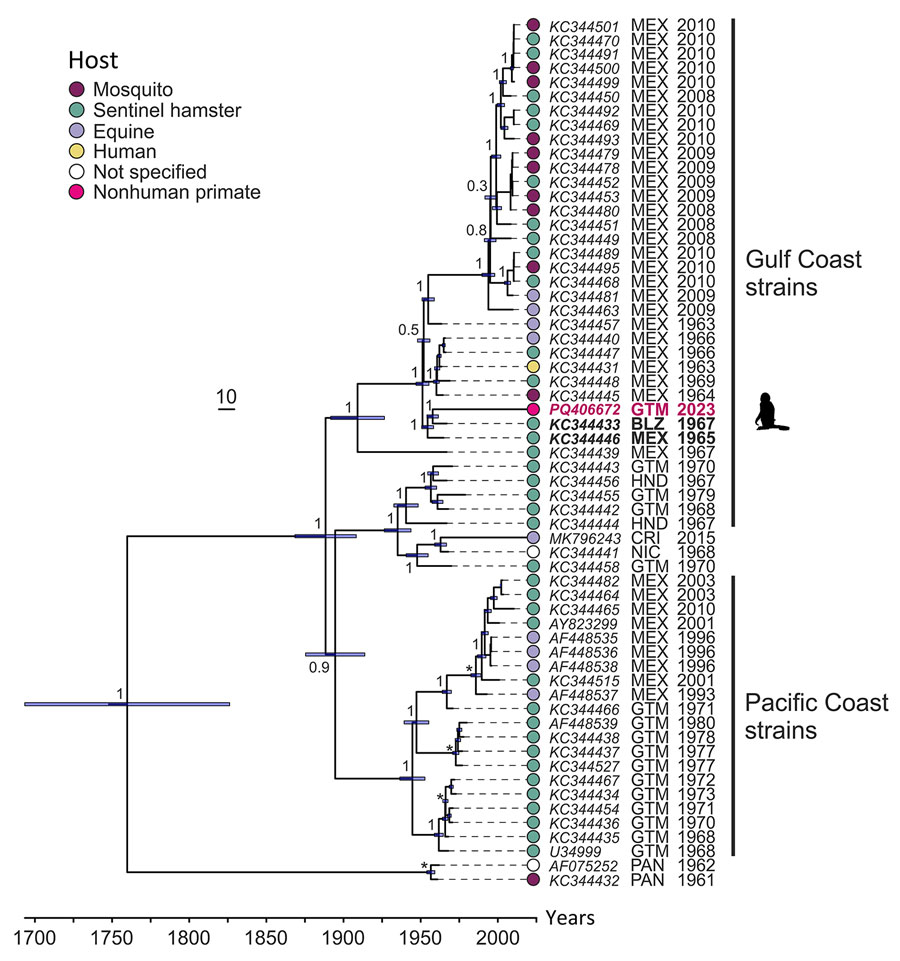Volume 31, Number 2—February 2025
Research Letter
Venezuelan Equine Encephalitis Virus Infection in Nonhuman Primate, Guatemala, 2023
Figure 2

Figure 2. Time-scaled Bayesian maximum-clade credibility tree of Venezuelan equine encephalitis virus subtype IE identified in Central America. Bayesian phylogeny of the concatenated nonstructural and structural open reading frames with removal of the coding regions for the C-terminus of nonstructural protein 3 and N terminus of the capsid protein. Taxa indicate GenBank accession number, country abbreviation, and year of collection. Branch tips indicate host by color coding, including a sequence (strain no. 63Z1) isolated from blood of a sick human infected in the rainforest near Sontecamapan, Veracruz, Mexico, in August 1963 (2). Numbers at nodes indicate posterior probabilities of all major branches. Asterisks indicate clades previously used for dating according to a previous publication (3). Bars in node branches represent the 95% height posterior density intervals of the node ages. Scale bar represents time in years. BLZ, Belize; CRI, Costa Rica; GTM, Guatemala; HND, Honduras; MEX, Mexico; NIC, Nicaragua; PAN, Panama; SLV, El Salvador.
References
- Brault AC, Powers AM, Holmes EC, Woelk CH, Weaver SC. Positively charged amino acid substitutions in the e2 envelope glycoprotein are associated with the emergence of venezuelan equine encephalitis virus. J Virol. 2002;76:1718–30. DOIPubMedGoogle Scholar
- Scherer WF, Campillo-Sainz C, de Mucha-Macías J, Dickerman RW, Chia CW, Zarate ML. Ecologic studies of Venezuelan encephalitis virus in southeastern Mexico. VII. Infection of man. Am J Trop Med Hyg. 1972;21:79–85. DOIPubMedGoogle Scholar
- Forrester NL, Wertheim JO, Dugan VG, Auguste AJ, Lin D, Adams AP, et al. Evolution and spread of Venezuelan equine encephalitis complex alphavirus in the Americas. PLoS Negl Trop Dis. 2017;11:
e0005693 . DOIPubMedGoogle Scholar - Adams AP, Navarro-Lopez R, Ramirez-Aguilar FJ, Lopez-Gonzalez I, Leal G, Flores-Mayorga JM, et al. Venezuelan equine encephalitis virus activity in the Gulf Coast region of Mexico, 2003-2010. PLoS Negl Trop Dis. 2012;6:
e1875 . DOIPubMedGoogle Scholar - Aguilar PV, Estrada-Franco JG, Navarro-Lopez R, Ferro C, Haddow AD, Weaver SC. Endemic Venezuelan equine encephalitis in the Americas: hidden under the dengue umbrella. Future Virol. 2011;6:721–40. DOIPubMedGoogle Scholar
- Oberste MS, Fraire M, Navarro R, Zepeda C, Zarate ML, Ludwig GV, et al. Association of Venezuelan equine encephalitis virus subtype IE with two equine epizootics in Mexico. Am J Trop Med Hyg. 1998;59:100–7. DOIPubMedGoogle Scholar
- Han BA, Kramer AM, Drake JM. Global patterns of zoonotic disease in mammals. Trends Parasitol. 2016;32:565–77. DOIPubMedGoogle Scholar
- Althouse BM, Guerbois M, Cummings DAT, Diop OM, Faye O, Faye A, et al. Role of monkeys in the sylvatic cycle of chikungunya virus in Senegal. Nat Commun. 2018;9:1046. DOIPubMedGoogle Scholar
- Moreira-Soto A, Torres MC, Lima de Mendonça MC, Mares-Guia MA, Dos Santos Rodrigues CD, Fabri AA, et al. Evidence for multiple sylvatic transmission cycles during the 2016-2017 yellow fever virus outbreak, Brazil. Clin Microbiol Infect. 2018;24:1019.e1–4. DOIPubMedGoogle Scholar
- Deardorff ER, Forrester NL, Travassos-da-Rosa AP, Estrada-Franco JG, Navarro-Lopez R, Tesh RB, et al. Experimental infection of potential reservoir hosts with Venezuelan equine encephalitis virus, Mexico. Emerg Infect Dis. 2009;15:519–25. DOIPubMedGoogle Scholar